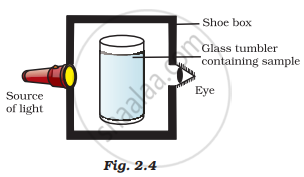Advertisements
Advertisements
प्रश्न
During an experiment, the students were asked to prepare a 10% (Mass/Mass) solution of sugar in water. Ramesh dissolved 10g of sugar in 100g of water while Sarika prepared it by dissolving 10g of sugar in water to make 100g of the solution.
(a) Are the two solutions of the same concentration
(b) Compare the mass % of the two solutions.
उत्तर
(a) No, Sarika has a higher mass percentage.
(b) Solution made by Ramesh
Mass % = `10/(10 + 100) xx 100`
= `10/110 xx 100`
= 9.09%
Solution made by Sarika -
Mass % = `10/100 xx 100`
= 10%
APPEARS IN
संबंधित प्रश्न
Identify the solutions among the following mixtures.
- Soil
- Sea water
- Air
- Coal
- Soda water
Explain the following giving an example.
Suspension
The component present in a lesser amount, in a solution, is called ______
Give an example of a solid in a liquid.
Give an example of gas in gas.
Smoke and fog both are aerosols. In what way are they different?
The teacher instructed three students ‘A’, ‘B’ and ‘C’ respectively to prepare a 50% (mass by volume) solution of sodium hydroxide (NaOH). ‘A’ dissolved 50g of NaOH in 100 mL of water, ‘B’ dissolved 50g of NaOH in 100g of water while ‘C’ dissolved 50g of NaOH in water to make 100 mL of solution. Which one of them has made the desired solution and why?
Name the process associated with the following
A potassium permanganate crystal is in a beaker and water is poured into the beaker with stirring.
A group of students took an old shoebox and covered it with black paper from all sides. They fixed a source of light (a torch) at one end of the box by making a hole in it and making another hole on the other side to view the light. They placed a milk sample contained in a beaker/tumbler in the box as shown in Fig.2.4. They were amazed to see that milk taken in the tumbler was illuminated. They tried the same activity by taking a salt solution but found that light simply passed through it?
(a) Explain why the milk sample was illuminated. Name the phenomenon involved.
(b) The same results were not observed with a salt solution. Explain.
(c) Can you suggest two more solutions that would show the same effect as shown by the milk solution?

When the solid (Solute) dissolves in a liquid (Solvent), it becomes a solution.
